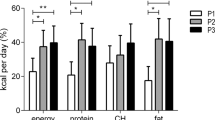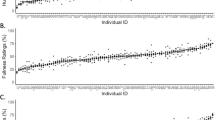Abstract
Objective:
To examine characteristics of craved foods in relation to dietary energy restriction (ER) with high (HG) and low glycemic load (LG) diets.
Design:
Assessments of food cravings before and during a randomized controlled trial of HG and LG diets provided for 6 months.
Subjects:
Thirty-two healthy, overweight women aged 20–42 years.
Measurements:
Self-reported food cravings and dietary intake, body weight, weight history and measures of eating behaviors.
Results:
Foods craved at baseline were more than twice as high in energy density as the habitual diet (3.7±1.5 vs 1.7±0.3 kcal/g; P<0.001), and on average were lower in protein (P<0.001) and fiber (P<0.001) and higher in fat (P=0.002). There were no statistically significant changes in nutritional characteristics of craved foods after 6 months of ER. There was a significant relationship between reported portion size of craved food consumed at baseline and lifetime high body mass index (r=0.49, P=0.005). Additionally, there was a significant association between susceptibility to hunger and craving frequency at baseline, and there were significant relationships between hunger score, craving frequency, strength and percentage of time that cravings are given in to after 6 months of ER. In multiple regression models, subjects who lost a greater percentage of weight craved higher energy-dense foods at month 6 of ER, but also reported giving in to food cravings less frequently (adjusted R2=0.31, P=0.009).
Conclusion:
High energy density and fat content, and low protein and fiber contents were identifying characteristics of craved foods. The relationships between craving variables and hunger score suggest that the relative influence of hunger susceptibility on cravings may be important before and especially after ER. Portion size of craved foods and frequency of giving in to food cravings appear to be important areas for focus in lifestyle modification programs for long-term weight loss.
This is a preview of subscription content, access via your institution
Access options
Subscribe to this journal
Receive 12 print issues and online access
$259.00 per year
only $21.58 per issue
Buy this article
- Purchase on Springer Link
- Instant access to full article PDF
Prices may be subject to local taxes which are calculated during checkout


Similar content being viewed by others
References
Weingarten HP, Elston D . The phenomenology of food cravings. Appetite 1990; 15: 231–246.
Gendall KA, Sullivan PF, Joyce PR, Fear JL, Bulik CM . Psychopathology and personality of young women who experience food cravings. Addict Behav 1997; 22: 545–555.
Gendall KA, Joyce PR, Sullivan PF . Impact of definition on prevalence of food cravings in a random sample of young women. Appetite 1997; 28: 63–72.
Weingarten HP, Elston D . Food cravings in a college population. Appetite 1991; 17: 167–175.
Christensen L, Pettijohn L . Mood and carbohydrate cravings. Appetite 2001; 36: 137–145.
Pelchat ML . Food cravings in young and elderly adults. Appetite 1997; 28: 103–113.
Buffenstein R, Poppitt SD, McDevitt RM, Prentice AM . Food intake and the menstrual cycle: a retrospective analysis, with implications for appetite research. Physiol Behav 1995; 58: 1067–1077.
Gendall KA, Joyce PR, Sullivan PF, Bulik CM . Food cravers: characteristics of those who binge. Int J Eat Disord 1998; 23: 353–360.
Delahanty LM, Meigs JB, Hayden D, Williamson DA, Nathan DM . Psychological and behavioral correlates of baseline BMI in the Diabetes Prevention Program (DPP). Diabetes Care 2002; 25: 1992–1998.
Franken IH, Muris P . Individual differences in reward sensitivity are related to food craving and relative body weight in healthy women. Appetite 2005; 45: 198–201.
Gibson EL, Desmond E . Chocolate craving and hunger state: implications for the acquisition and expression of appetite and food choice. Appetite 1999; 32: 219–240.
Gibson EL . Learning in the development of food craving. In: Hetherington M (ed), Food Cravings and Addiction. Leatherhead Publishing: Leatherhead, 2001. pp 193–234.
Berridge KC . Food reward: brain substrates of wanting and liking. Neurosci Biobehav Rev 1996; 20: 1–25.
Martel P, Fantino M . Mesolimbic dopaminergic system activity as a function of food reward: a microdialysis study. Pharmacol Biochem Behav 1996; 53: 221–226.
Mercer ME, Holder MD . Food cravings, endogenous opioid peptides, and food intake: a review. Appetite 1997; 29: 325–352.
Cornell CE, Rodin J, Weingarten H . Stimulus-induced eating when satiated. Physiol Behav 1989; 45: 695–704.
Lambert KG, Neal T, Noyes J, Parker C, Worrel P . Food-related stimuli increase desire to eat in hungry and satiated human subjects. Curr Psychol Res and Rev 1991; 10: 297–303.
Hill AJ, Weaver CF, Blundell JE . Food craving, dietary restraint and mood. Appetite 1991; 17: 187–197.
Rosen JC . Effects of low-calorie dieting and exposure to diet-prohibited food on appetite and anxiety. Appetite 1981; 2: 366–369.
Tiggemann M, Kemps E . The phenomenology of food cravings: the role of mental imagery. Appetite 2005; 45: 305–313.
Pelchat ML, Schaefer S . Dietary monotony and food cravings in young and elderly adults. Physiol Behav 2000; 68: 353–359.
Pelchat ML, Johnson A, Chan R, Valdez J, Ragland JD . Images of desire: food-craving activation during fMRI. Neuroimage 2004; 23: 1486–1493.
Harvey J, Wing RR, Mullen M . Effects on food cravings of a very low calorie diet or a balanced, low calorie diet. Appetite 1993; 21: 105–115.
Martin CK, O'Neill PM, Pawlow L . Changes in food cravings during low-calorie and very-low-calorie diets. Obesity 2006; 14: 115–121.
Raynor HA, Epstein LH . The relative-reinforcing value of food under differing levels of food deprivation and restriction. Appetite 2003; 40: 15–24.
Lappalainen R, Sjoden PO, Hursti T, Vesa V . Hunger/craving responses and reactivity to food stimuli during fasting and dieting. Int J Obes 1990; 14: 679–688.
Morreale SJ, Schwartz NE . Helping Americans eat right: developing practical and actionable public nutrition education messages based on the ADA Survey of American Dietary Habits. J Am Diet Assoc 1995; 95: 305–308.
LaPorte DJ, Stunkard AJ . Predicting attrition and adherence to a very low calorie diet: a prospective investigation of the eating inventory. Int J Obes 1990; 14: 197–206.
Lafay L, Thomas F, Mennen L, Charles MA, Eschwege E, Borys JM et al. Gender differences in the relation between food cravings and mood in an adult community: Results from the fleurbaix laventie ville sante study. Int J Eat Disord 2001; 29: 195–204.
Cooper Z, Cooper P, Fairburn C . The validity of the eating disorder examination and its subscales. Br J Psychiatry 1989; 154: 807–812.
Stunkard AJ, Messick S . The three-factor eating questionnaire to measure dietary restraint, disinhibition and hunger. J Psychosom Res 1985; 29: 71–83.
Institute of Medicine. Dietary Reference Intakes for Energy, Carbohydrate, Fiber, Fat, Fatty Acids, Cholesterol, Protein, and Amino Acids (Macronutrients). A Report of the Panel on Macronutrients, Subcommittees on Upper Reference Levels of Nutrients and Interpretation and Uses of Dietary Reference Intakes, and the Standing Committee on the Scientific Evaluation of Dietary Reference Intakes. National Academy Press: Washington, DC, 2005.
Schoeller D . Measurement of energy expenditure in free-living humans by using doubly labeled water. J Nutr 1988; 118: 1278–1289.
Das SD, Gilhooly CH, Golden JK, Pittas AG, Fuss PJ, Cheatham RA et al. Long-term effects of two energy-restricted diets differing in glycemic load on dietary adherence, body composition and metabolism in CALERIE, a one year randomized controlled trial. Am J Clin Nutr 2007; 85: 1023–1030.
Hays NP, Bathalon GP, McCrory MA, Roubenoff R, Lipman R, Roberts SB . Eating behavior correlates of adult weight gain and obesity in healthy women aged 55–65 y. Am J Clin Nutr 2002; 75: 476–483.
Dempster P, Aitkens S . A new air displacement method for the determination of human body composition. Med Sci Sports Exerc 1995; 27: 1692–1697.
McCrory M, Gomez T, Bernauer E, Mole P . Evaluation of a new air displacement plethysmograph for measuring human body composition. Med Sci Sports Exerc 1995; 27: 1686–1691.
Schakel SF, Sievert YA, Buzzard IM . Sources of data for developing and maintaining a nutrient database. J Am Diet Assoc 1988; 88: 1268–1271.
Cox DN, Mela DJ . Determination of energy density of freely selected diets: methodological issues and implications. Int J Obes Relat Metab Disord 2000; 24: 49–54.
Ledikwe JH, Blanck HM, Khan LK, Serdula MK, Seymour JD, Tohill BC et al. Dietary energy density determined by eight calculation methods in a nationally representative United States population. J Nutrition 2005; 135: 273–278.
Rodin J, Mancuso J, Granger J, Nelbach E . Food cravings in relation to body mass index, restraint and estradiol levels: a repeated measures study in healthy women. Appetite 1991; 17: 177–185.
Hill AJ, Heaton-Brown L . The experience of food craving: a prospective investigation in healthy women. J Psychosom Res 1994; 38: 801–814.
McCrory M, Hajduk C, Roberts S . Procedures for screening out inaccurate reports of dietary energy intake. Public Health Nutr 2002; 5: 873–882.
Huang TT, Roberts SB, Howarth NC, McCrory MA . Effect of screening out implausible energy intake reports on relationships between diet and BMI. Obes Res 2005; 13: 1205–1217.
Cepeda-Benito A, Gleaves DH . A critique of food cravings research: theory, measurement, and food intake. In: Hetherington M (ed), Food Cravings and Addiction. Leatherhead Publishing: Leatherhead, 2001, pp 3–29.
Yanovski S . Sugar and fat: cravings and aversions. J Nutr 2003; 133: 835S–837S.
Rolls ET . Smell, taste, texture, and temperature multimodal representations in the brain, and their relevance to the control of appetite. Nutr Rev 2004; 62: S193–S204.
Rolls ET . Taste and olfactory processing in the brain and its relation to the control of eating. Crit Rev Neurobiol 1997; 11: 263–287.
Drewnowski A . Energy intake and sensory properties of food. Am J Clin Nutr 1995; 62: 1081S–1085S.
Howarth NC, Saltzman E, Roberts SB . Dietary fiber and weight regulation. Nutr Rev 2001; 59: 129–139.
Rogers PJ, Smit HJ . Food craving and food ‘addiction’: a critical review of the evidence from a biopsychosocial perspective. Pharmacol Biochem Behav 2000; 66: 3–14.
Rolls BJ . Sensory-specific satiety. Nutr Rev 1986; 44: 93–101.
Epstein L, Rodefer J, Wisniewski L, Caggiula A . Habituation and dishabituation of human salivary resonse. Physiol Behav 1992; 51: 945–950.
Sorensen LB, Moller P, Flint A, Martens M, Raben A . Effect of sensory perception of foods on appetite and food intake: a review of studies on humans. Int J Obes Relat Metab Disord 2003; 27: 1152–1166.
Acknowledgements
We thank the extremely dedicated volunteers who participated in this study as well as the staff of the Metabolic Research Unit for their knowledge and dedication throughout this project. This study was supported by NIH Grant no. U01-AG20480, the US Department of Agriculture, under agreement no. 58-1950-4-401 and the Boston Obesity Nutrition Research Center Grant no. H150001. Any opinions, findings, conclusion or recommendations expressed in this publication are those of the authors and do not necessarily reflect the view of the US Department of Agriculture or the US Food and Drug Administration.
Author information
Authors and Affiliations
Corresponding author
Rights and permissions
About this article
Cite this article
Gilhooly, C., Das, S., Golden, J. et al. Food cravings and energy regulation: the characteristics of craved foods and their relationship with eating behaviors and weight change during 6 months of dietary energy restriction. Int J Obes 31, 1849–1858 (2007). https://doi.org/10.1038/sj.ijo.0803672
Received:
Revised:
Accepted:
Published:
Issue Date:
DOI: https://doi.org/10.1038/sj.ijo.0803672
Keywords
This article is cited by
-
Study protocol of the sweet tooth study, randomized controlled trial with partial food provision on the effect of low, regular and high dietary sweetness exposure on sweetness preferences in Dutch adults
BMC Public Health (2023)
-
The food craving inventory in an Iranian population: post-hoc validation and individual differences
Eating and Weight Disorders - Studies on Anorexia, Bulimia and Obesity (2021)
-
Obesità e dieta: mantenimento del peso dopo calo ponderale
L'Endocrinologo (2019)
-
The relationship of weight suppression to treatment outcomes during behavioral weight loss
Journal of Behavioral Medicine (2019)
-
Food craving predicts the consumption of highly palatable food but not bland food
Eating and Weight Disorders - Studies on Anorexia, Bulimia and Obesity (2019)



